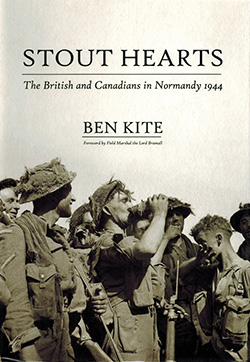Book Reviews

Stout Hearts The British and Canadians in Normandy 1944
by Ben Kite
Solihull: Helion & Company, 2014
476 pages, $46.95
ISBN: 978-1-909982-55-0
For more information on accessing this file, please visit our help page.
Reviewed by David Yarker
Stout Hearts: The British and Canadians in Normandy 1944, is an interesting and somewhat surprising book. The author, Ben Kite, is a serving member of the British Intelligence Corps with substantial operational experience, and, rather than provide yet another narrative examination of the Normandy Campaign, his book aims to explain “how an Army actually ‘works’ on operations.” He does this through a detailed examination of a specific Army in a specific campaign – the 21st Army Group in Normandy. Therefore, although the book is ‘about’ the British-Canadian Army in Normandy, its real focus is upon what that Army, and, by extension, what a modern Army in general, really is.
To accomplish this goal, the author relies upon two interconnected structures. The first is the use of the various components of the Army to provide the broad narrative structure. After a swift overview of the Normandy Campaign (dispatched in six pages, including a photograph) the book settles into ten chapters which examine, in turn, the major components of the Army, beginning with the infantry and covering the remaining combat arms, along with less commonly-examined components that make an Army more than the sum of its units: medical, intelligence, logistics, naval and air support, and staff and headquarters structures. Each of these chapters includes an overview of the role of the element within the Army and its major equipment and tactics. Some of these chapters, particularly those on less commonly-discussed elements, such as medical or intelligence support, contain interesting perspectives rarely found in other campaign histories.
What really makes the book interesting, however, is a very heavy reliance upon direct quotations from those who served in the campaign. The book is filled with lengthy quotes from a wide variety of personnel at all levels who served with the 21st Army Group in Normandy. Many of these are from previously unpublished sources. Without doubt, this approach provides the strength of the book, and helps draw the reader through what can occasionally be quite technical discussions. Rarely, one of the quotations does not land quite perfectly, or is not exactly ‘on point,’ and it disrupts the tempo or tone of the book. Overall, however, it is testament to the quality of the book that the vast majority of these lengthy quotes hold together extremely well, and they produce a coherent picture of both a generic Army on operations, and the Normandy campaign itself. The narrative is further supplemented through the liberal use of photographs, maps, and charts to provide further support for both the personal narratives, as well as the technical points made by the author.
These two interconnected structures allow the Normandy Campaign itself play out as backdrop to the two goals the book admirably achieves: to examine what a modern Army is, and to hear that directly from the soldiers who fought in Normandy. One minor weakness of the book is its conclusion. Although it satisfactorily closes off the campaign, some of the lessons identified, for example, the assertion that division is the critical level of warfare, do not flow smoothly from the remainder of the book. However, the conclusion is short and does nothing to distract from the enjoyment of having spent several hundred pages in the bocage of Normandy getting to know a modern Army. Again, this is the real strength of the book – breathing life into an Army on campaign.
Stout Hearts is well suited those seeking to develop a general understanding of modern land operations, but will also be of interest to those with more experience. Throughout the book, I was struck by how familiar the broad structures of 21st Army Group were, and I found it allowed me to bring my own experiences five decades later as a junior officer in 2 Brigade to better understand Normandy. By avoiding lecturing the reader with respect to the structure of an Army, but rather, providing an opportunity for comprehension to grow by examining the component parts in the words of those who served, Ben Kite has produced a fascinating perspective on an Army in operations.
Lieutenant-Colonel David Yarker, CD, is a currently serving member of the Royal Canadian Corps of Signals and a graduate of RMC in Engineering Physics, History and Defence Science.







